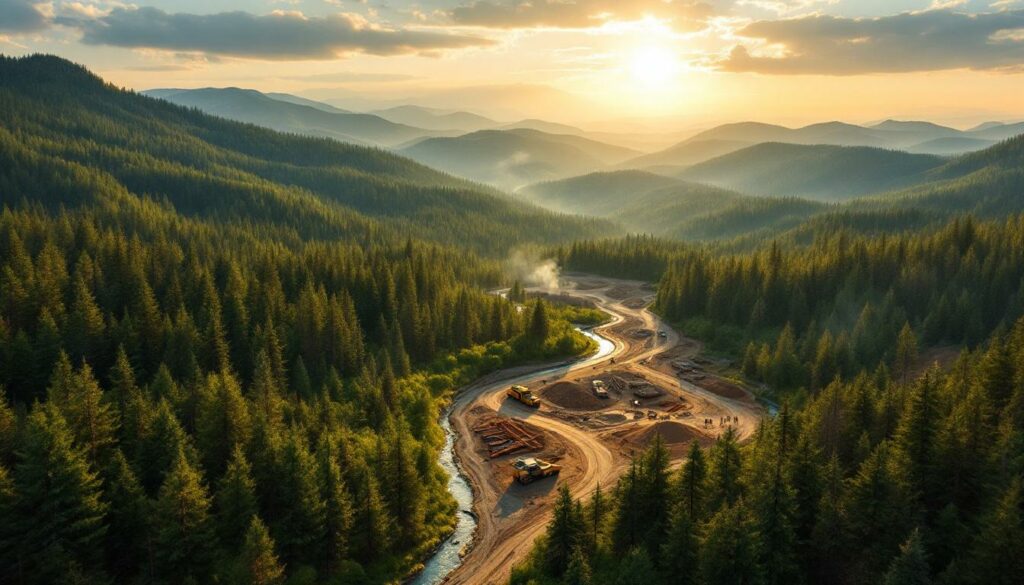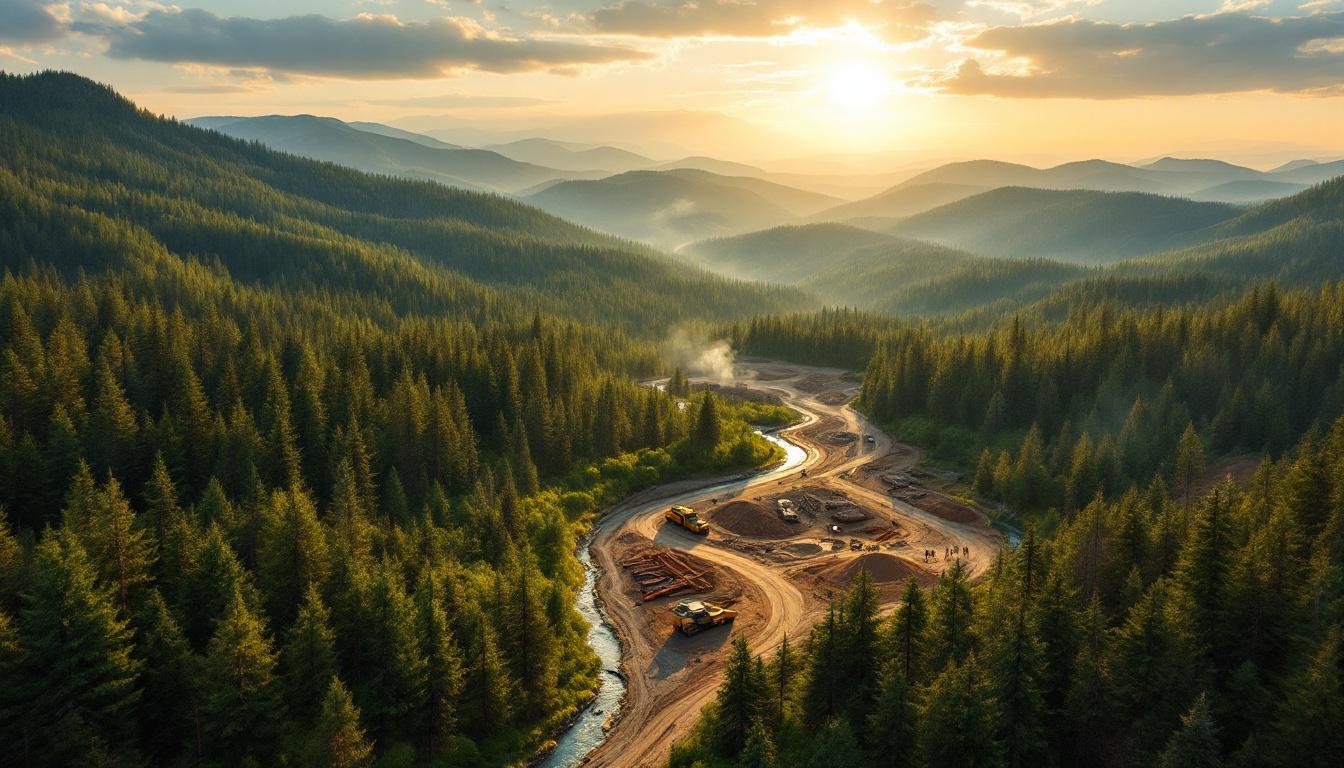US Plans to Allow Mining and Other Activities in Undeveloped Forest Areas
In a significant shift in environmental policy, the US Department of Agriculture (USDA) has announced plans to repeal the 2001 Roadless Area Conservation Rule, opening nearly 24 million hectares of previously protected federal forest land to potential development. This June 2025 decision marks a dramatic reversal of a Clinton-era conservation measure that has safeguarded undeveloped forest areas for over two decades and signals a fundamental change in how America's forests will be managed.
What is the New US Forest Management Policy?
The USDA's announcement, delivered by Agriculture Secretary Brooke Rollins at the Western Governors' Association meeting in Santa Fe on June 23, 2025, effectively eliminates the 2001 Roadless Area Conservation Rule. This landmark policy shift removes longstanding restrictions on road construction, logging, and mining activities across vast tracts of previously protected national forest land.
Key Elements of the Policy Change
The new policy fundamentally transforms forest management by:
- Eliminating restrictions on road building in previously protected "inventoried roadless areas"
- Opening undeveloped forest ecosystems to commercial timber harvesting
- Creating access for mining operations in previously inaccessible regions
- Transferring greater decision-making authority to local forest managers
- Affecting approximately 30% of all US Forest Service (USFS) managed lands
"After repealing this regulation, we now want to return to traditional forest management practices to ensure our forests benefit future generations," stated Agriculture Secretary Brooke Rollins during the announcement.
The policy shift represents the administration's vision of decentralized forest management, emphasizing local control and expanded resource utilization over the preservation-focused approach that has dominated for more than 20 years. While the repeal has been announced, implementation will require adjustments to existing forest management plans across the country.
Why is the US Government Changing Forest Management Policies?
Fire Risk Management Claims
Central to the administration's justification for repealing the Roadless Rule is the argument that current restrictions impede effective wildfire prevention efforts. According to USDA officials, limitations on forest thinning and management activities have contributed to deteriorating forest health and increasing wildfire severity.
Agriculture Secretary Rollins directly linked the policy change to fire prevention during her announcement: "This misleading regulation restricted USFS from thinning trees to prevent wildfires." The administration has cited internal data suggesting that wildfire-destroyed forest areas have doubled since the rule's implementation in 2001.
Proponents of the change argue that:
- Limited access has prevented necessary mechanical thinning operations
- Fuel load accumulation in roadless areas creates higher wildfire risk
- Local forest managers need flexibility to implement site-specific fire prevention strategies
- Current regulations create bureaucratic obstacles to timely interventions
However, this fire prevention justification faces significant scientific scrutiny. Earthjustice, a prominent environmental law organization, counters that roads may actually increase wildfire risks by introducing more human activity—the primary source of wildfire ignitions—into previously undisturbed areas.
Economic and Industry Considerations
Beyond fire management concerns, the policy change aligns with broader administration goals to reduce environmental regulations and expand resource development opportunities. The economic motivation includes:
- Creating new timber harvesting opportunities in previously inaccessible areas
- Opening mineral-rich lands for exploration and extraction
- Generating rural employment through expanded resource industries
- Reducing regulatory burden on forest product and mining companies
The policy mirrors earlier deregulation priorities by prioritizing economic access to natural resources over conservation values. With approximately 60% of forest land in states like Utah and Montana currently prohibiting road construction, the economic potential for industries seeking access to these resources is substantial.
How Much Forest Land Will Be Affected?
Scope of Impact
The policy change impacts an extraordinary amount of public land—23.9 million hectares (approximately 59 million acres) of federal forest. To put this in perspective:
| Comparison | Area (approx.) |
|---|---|
| Total affected forest land | 23.9 million hectares |
| Percentage of USFS lands | 30% |
| Equivalent to | The size of Italy |
| Previously inaccessible to development | 100% |
Drew Caputo, Vice President of Litigation at Earthjustice, emphasized the scale: "The Roadless Rule protected 58 million acres of national forests… lands that belong to all the people of the US, not the timber industry."
This massive land area represents some of America's most pristine remaining forest ecosystems—lands that have remained largely undisturbed by industrial development. The affected areas include critical wildlife habitat, watershed protection zones, and carbon sequestration resources.
Regional Distribution
The impact of this policy change will not be evenly distributed across the country. Western states with large national forests will experience the most significant effects:
- Alaska: The Tongass National Forest, America's largest national forest at 6.7 million hectares, will once again face potential development after being exempted in 2020, restored in 2023, and now re-opened.
- Mountain West: States like Montana, Idaho, Wyoming, and Utah contain the majority of inventoried roadless areas, with approximately 60% of their forest land previously closed to road construction.
- Pacific Northwest: Oregon and Washington's old-growth forests contain significant roadless areas now potentially open to timber harvesting.
- Southwest: Arizona and New Mexico's high-elevation forests, critical for regional water security, face potential fragmentation.
These regions contain some of the nation's most ecologically valuable forests, providing clean water, wildlife habitat, recreational opportunities, and carbon storage that mitigates climate change.
What Are the Environmental Concerns?
Conservation Perspectives
Environmental organizations have raised immediate alarm about the wide-ranging ecological impacts of this policy reversal. Primary concerns include:
- Ecosystem fragmentation: Road networks divide continuous habitat into isolated patches, compromising wildlife movement corridors and reducing genetic diversity
- Increased human disturbance: Roads facilitate human access that introduces noise, pollution, and disruption to sensitive wildlife
- Invasive species introduction: Vehicles and equipment transport non-native plants and animals into previously isolated ecosystems
- Water quality degradation: Road construction and use increases erosion and sedimentation in forest streams and rivers
- Loss of reference ecosystems: Undisturbed forests provide crucial baseline data for ecological research and understanding
Earthjustice has directly challenged the administration's fire prevention justification, noting that roads themselves often increase fire ignition risks by facilitating human access, which is responsible for approximately 85% of wildfire starts.
"These lands belong to all the people of the US, not the timber industry," stated Drew Caputo of Earthjustice, highlighting the public trust aspect of national forest management.
Climate Change Considerations
The climate implications of this policy shift are particularly significant as forests play a crucial role in carbon sequestration. According to USFS Carbon Assessment data, roadless areas store approximately 1.8 metric tons of carbon per hectare annually, making them vital climate stabilization resources.
New Mexico Governor Michelle Lujan Grisham directly challenged the administration's fire prevention justification, stating that "climate change—not lack of management—drives destructive fires." This perspective reflects growing scientific consensus that climate-induced drought, higher temperatures, and extended fire seasons are the primary drivers of increasing wildfire intensity.
Additional climate concerns include:
- Reduced carbon sequestration if significant forest areas are harvested
- Loss of climate refugia for temperature-sensitive species
- Potential methane releases from mining operations in newly accessible areas
- Increased carbon emissions from both forest reduction and industrial activities
Environmental scientists emphasize that intact forest ecosystems represent one of America's most important natural climate solutions, and fragmentation compromises this function at a critical time in climate mitigation efforts.
Who Supports and Opposes the Policy Change?
Supporters' Arguments
The policy shift has generated strong support from several key constituencies:
Timber Industry Representatives have welcomed the increased access to previously unavailable forest resources. The industry, which contributed approximately $13 billion to rural economies in 2024 according to the American Forest & Paper Association, anticipates expanded harvesting opportunities and associated economic benefits.
Mining Companies view the policy as removing a significant barrier to exploration and development. Understanding mining permitting basics is crucial for companies seeking to navigate the new opportunities this policy creates in previously protected areas. The industry has long sought access to mineral deposits located within roadless areas, arguing that domestic resource development reduces reliance on imported materials.
Some Local Governments in rural forest communities favor the change, anticipating economic development opportunities through increased resource extraction and associated service industries. These communities often face economic challenges and view forest resources as potential drivers of growth.
Administration Officials continue to emphasize forest health and fire prevention benefits, presenting the policy as a pragmatic approach to managing increasingly fire-prone landscapes in a changing climate.
Opposition Perspectives
Opposition to the policy change has been swift and organized:
Environmental Organizations including Earthjustice, The Wilderness Society, and Sierra Club have announced plans to challenge the decision through litigation, arguing that the change violates multiple environmental laws including the National Environmental Policy Act (NEPA).
Indigenous Tribes with cultural and historical connections to affected forests have raised concerns about threats to sacred sites, traditional food gathering areas, and tribal sovereignty over ancestral lands.
Climate Scientists have highlighted the carbon sequestration value of intact forests, warning that increased development could compromise this natural climate solution at a critical time.
Outdoor Recreation Industry representatives have expressed concern that road construction and industrial development will diminish wilderness experiences that drive their $887 billion industry, according to Outdoor Industry Association figures.
The stark division of perspectives reflects fundamentally different values regarding the purpose and management of public forests—resource utilization versus ecosystem preservation, economic development versus environmental protection, local control versus national interest.
What Happens Next for US Forest Management?
Implementation Timeline
While the policy change has been announced, the path to implementation involves several stages:
- Formal Rule Publication (Expected July 2025): The USDA must publish the final rule in the Federal Register
- Public Comment Period (30-90 days): The public will have an opportunity to submit comments on the implementation
- Regional Implementation Plans (2025-2026): Individual national forests must update their management plans
- Project-Level Approvals (12-24 months): Specific development proposals will require environmental reviews
- Potential Litigation Delays (2-5 years): Legal challenges could extend the timeline considerably
This extended timeline means that while the policy change has been announced, actual on-the-ground development may not begin for several years, particularly if legal challenges proceed as expected.
Potential Legal Challenges
Environmental organizations are already preparing legal challenges that could significantly delay or modify implementation:
- NEPA Compliance: Challenges may focus on the adequacy of environmental impact assessments
- Administrative Procedure Act: Questions about whether proper procedures were followed in the rulemaking process
- Endangered Species Act: Potential impacts on protected wildlife could trigger additional legal hurdles
- Multiple-Use Mandate: Arguments that the change violates the Forest Service's obligation to balance competing uses
The original 2001 Roadless Rule survived more than 20 legal challenges over two decades, suggesting that this reversal will likely face similar scrutiny. The courts will ultimately determine whether the administration has adequately justified such a significant policy shift.
How Does This Compare to Previous Forest Policy Changes?
Historical Context
This policy reversal represents the latest swing in a pendulum of forest management approaches that has characterized US environmental policy for decades:
- 2001: Clinton administration establishes the Roadless Area Conservation Rule
- 2005-2012: Bush administration attempts multiple modifications, most blocked by courts
- 2020: Trump administration exempts Tongass National Forest from Roadless Rule
- 2023: Biden administration restores Roadless Rule protections to Tongass
- 2025: Current administration repeals Roadless Rule entirely
This pattern reflects the broader oscillation between conservation and development priorities that occurs with changing administrations. Furthermore, the recent executive order on critical minerals represents another significant step in prioritizing resource extraction on public lands. Each shift creates uncertainty for both conservation planning and industry investment strategies.
Regulatory Precedent
The current policy change establishes several important precedents for environmental management:
- It demonstrates the vulnerability of major conservation policies to administrative changes without congressional approval
- It raises questions about the long-term stability of environmental protections on public lands
- It highlights the tension between federal oversight and local management of national resources
- It may embolden future administrations to make similarly sweeping changes to other environmental regulations
This approach to public lands management—through administrative action rather than legislative change—means that forest policy may continue to shift with each change in administration, creating a planning and management environment characterized by uncertainty.
FAQ About US Forest Management Policy Changes
Will this policy change immediately allow mining in all protected forests?
No. While the policy removes blanket protections, individual projects would still require permits and environmental reviews under laws like the National Environmental Policy Act (NEPA), Clean Water Act, and Endangered Species Act. The change creates the potential for development but doesn't automatically approve specific projects. Each proposed mining operation would need to complete the appropriate environmental assessment process and obtain necessary permits, which typically takes 2-5 years.
How might this affect recreational access to national forests?
The policy will likely create a mixed impact on recreation. On one hand, road construction could increase vehicular access to previously remote areas, potentially expanding opportunities for activities like car camping, day hiking, and mountain biking. On the other hand, the wilderness experience sought by backpackers, hunters, and anglers who value undeveloped landscapes could be diminished. The outdoor recreation industry, worth nearly $900 billion annually, has expressed concern that industrial development could compromise the natural experiences that drive their customer base.
What economic impact could this policy have?
The economic impacts will vary significantly by region and industry:
- Timber Industry: Could see expanded harvesting opportunities, particularly in states with extensive roadless areas like Idaho, Montana, and Alaska
- Mining Sector: May gain access to previously unavailable mineral deposits, though development timeframes would be extended due to permitting requirements
- Tourism: Communities dependent on wilderness recreation could experience negative impacts if natural areas are degraded
- Rural Development: Some forest-adjacent communities might see job growth in resource extraction sectors
The US government's updated critical minerals strategy is closely tied to these economic considerations, particularly as it relates to expanding domestic resource production. The distribution of economic benefits and costs remains highly debated, with industry groups projecting job creation while environmental economists point to potential losses in recreation-based economies and ecosystem services.
How will this affect efforts to combat climate change?
Opening roadless areas to development could potentially reduce carbon sequestration capacity if significant forest clearing occurs. Forests in roadless areas currently store approximately 1.8 metric tons of carbon per hectare annually, making them important climate stabilization resources. However, the actual climate impact will depend on:
- The extent of forest removal ultimately permitted
- The type of activities conducted (selective logging vs. clear-cutting)
- The carbon intensity of approved mining operations
- Whether harvested areas are promptly reforested
- How forest products are used (long-term construction materials vs. short-lived products)
Climate scientists generally agree that maintaining intact forest ecosystems represents one of the most cost-effective climate mitigation strategies available.
Will wilderness areas and national parks be affected by this policy change?
No. This policy specifically affects "inventoried roadless areas" within National Forests, not designated Wilderness Areas or National Parks, which are protected by different legislation. Congressionally designated Wilderness Areas remain protected under the 1964 Wilderness Act, while National Parks are managed by the Department of the Interior under separate regulations. However, the policy change could affect roadless areas adjacent to these protected lands, potentially creating edge effects and ecological impacts that cross boundaries.
What alternatives exist for balancing forest management and conservation?
Several alternative approaches have been proposed by forestry experts:
- Targeted Management: Focusing forest health treatments near communities and infrastructure rather than remote backcountry
- Collaborative Governance: Engaging diverse stakeholders including tribes, scientists, industry, and communities in management decisions
- Conservation Easements: Using legal agreements to protect key ecological areas while allowing limited management
- Carbon Markets: Creating economic incentives for forest preservation through carbon sequestration credits
- Sustainable Certification: Promoting environmentally responsible timber harvesting through third-party verification
These approaches aim to balance ecological protection with human needs while avoiding the all-or-nothing extremes that characterize much of the current policy debate.
How might climate change influence these forest management decisions?
Climate change is fundamentally altering forest ecosystems through:
- Shifting temperature and precipitation patterns
- Increased drought stress and fire risk
- Changing insect and disease dynamics
- Altered species distributions and migration patterns
These changes complicate forest management decisions by making historical conditions less relevant for future planning. Both supporters and opponents of the policy change cite climate concerns, though they reach different conclusions about appropriate responses. While supporters argue for active management to address changing conditions, opponents emphasize the importance of intact forests as climate refugia and carbon sinks.
Understanding the mine reclamation importance becomes particularly relevant as new mining operations may be permitted in these previously protected areas. Proper restoration of disturbed lands will be critical to minimizing long-term environmental impacts.
The future of these forests may also depend on ongoing mineral exploration insights that guide how and where companies decide to develop resources within newly accessible areas.
Disclaimer: This article presents information about a proposed policy change with significant economic
Want to Get Ahead of Major ASX Mining Discoveries?
Don't miss potentially transformative investment opportunities on the ASX. Visit Discovery Alert's discoveries page to see how their proprietary Discovery IQ model delivers real-time alerts on significant mineral discoveries, giving subscribers a crucial market advantage before news becomes mainstream.




